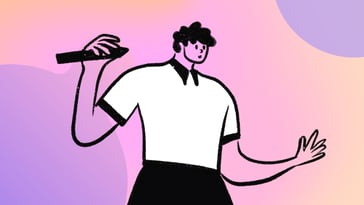Vulnerability Management plays a crucial role in the world of cybersecurity addressing both security vulnerabilities and software vulnerabilities to keep digital threats and cyber attacks at bay. What started as simple antivirus programs has transformed into complex, AI-driven solutions built to combat increasingly sophisticated threats. This evolution has shaped Vulnerability Management into a vital part of any modern security strategy.
In this article, we’ll take you on a journey through the history of Vulnerability Management, best practices for today, and a glimpse of what the future holds. Get ready for a deep dive into the past, present, and future of securing digital environments.

What is Vulnerability Management?
At its core, Vulnerability Management is about staying a step ahead of threats. It’s the continuous process of identifying, assessing, and resolving security weaknesses in an organization’s digital ecosystem.
Vulnerability Management goes beyond just fixing issues; it’s about building a proactive cybersecurity stance. Think of it as a digital health check that includes everything from detection to remediation—ensuring no vulnerability gets ignored.
Why is Vulnerability Management important?
The consequences of vulnerabilities are real and sometimes devastating, leading to data breaches, operational shutdowns, and lasting reputational damage.
A solid Vulnerability Management process helps minimize these risks, meets regulatory requirements, and builds a resilient defense posture against new threats.

Key elements of a strong Vulnerability Management program
Implementing effective Vulnerability Management requires essential components that help organizations stay cyber-resilient. These components include continuous monitoring, vulnerability scanning, and skilled security professionals.
1. Continuous monitoring and timely updates
Staying on top of vulnerabilities requires vigilance. Security teams use real-time scans and threat intelligence to identify, prioritize, and fix vulnerabilities before they’re exploited. This ongoing process is the foundation of proactive Vulnerability Management.
2. Vulnerability scanners and regular assessments
Vulnerability scanners are specialized tools help pinpoint weak spots and ensure that vulnerabilities are prioritized by risk level, allowing IT teams to focus on high-impact fixes. This approach to vulnerability assessments helps minimize potential threats before they escalate.
3. Skilled security professionals
Behind every successful Vulnerability Management program is a team of skilled security professionals who drive assessment, mitigation, and continuous improvement. Their expertise ensures that organizations stay prepared for emerging threats and secure their digital environments effectively.
Types of network vulnerabilities
Not all vulnerabilities are created equal. Each type requires a tailored approach to ensure a comprehensive cybersecurity strategy.
1. Operating system vulnerabilities
Outdated operating systems create vulnerabilities that are prime targets for cyber threats, making regular updates essential to block potential exploits. Without these updates, organizations leave themselves open to attacks that could compromise critical systems.
2. Application vulnerabilities
Application vulnerabilities are common in software that has weak security practices. Unaddressed flaws in applications become prime entry points, so ongoing assessment is key. Securing applications requires continuous monitoring to ensure they are free of security gaps.
3. Network configuration vulnerabilities
Misconfigurations, like open ports, leave systems exposed. Regular scanning helps ensure these errors are corrected before they become security issues. By identifying configuration vulnerabilities, organizations can strengthen their networks and reduce unauthorized access points.

A look at the Vulnerability Management lifecycle
A strong Vulnerability Management lifecycle guides organizations from identifying threats to taking action. The lifecycle structure ensures that vulnerabilities are addressed in a systematic way, reducing the chance of oversight.
1. Discovery and scanning
The Vulnerability Management lifecycle begins with discovery. Automated tools assess systems to reveal any lurking vulnerabilities. This stage is critical, as it provides a baseline for identifying potential risks across the organization’s entire digital ecosystem.
2. Categorization and prioritization
Once vulnerabilities are identified, they are categorized by severity, allowing security teams to address high-impact risks first. This prioritization helps streamline remediation efforts, ensuring that the most critical issues receive immediate attention.
3. Remediation and monitoring
Following prioritization, vulnerabilities are remediated, often through patching or reconfiguring systems to remove security gaps. Continuous monitoring then keeps new and re-emerging threats in check, helping teams maintain an active defense.
4. Reporting and reassessment
Periodic reporting and reassessment close the Vulnerability Management lifecycle. This stage involves analyzing the impact of previous vulnerabilities and identifying improvement areas, ensuring that the organization’s security strategies remain resilient and effective over time.
Key features in Vulnerability Management tools
Modern Vulnerability Management tools bring together a host of features to streamline cybersecurity efforts and make the Vulnerability Management process more efficient.
1. Automation and scanning
Automation simplifies the vulnerability scanning process, enabling more frequent assessments. By automating these tasks, organizations can ensure that any emerging weaknesses are identified and addressed quickly, reducing the risk of successful attacks.
2. Centralized dashboards and reporting
Centralized dashboards provide a real-time overview of vulnerabilities across systems, allowing security teams to monitor risks effectively. Reporting features track progress, document remediation efforts, and support compliance by generating detailed vulnerability assessment reports.
3. Integrated patching and tracking
Tools that integrate patching with vulnerability tracking ensure that fixes are implemented promptly and consistently. This integration allows security teams to address vulnerabilities before they’re exploited, creating a streamlined remediation process.

The role of continuous security scanning
Continuous security scanning is more than a best practice; it’s an essential part of modern Vulnerability Management. This approach allows organizations to stay vigilant in an ever-changing threat landscape.
1. Real-time visibility
Continuous scanning provides an up-to-the-minute view of an organization’s cybersecurity health. With real-time visibility, teams can spot vulnerabilities before they become problems, enhancing their ability to respond quickly to potential threats.
2. Reduced downtime
By catching vulnerabilities early, continuous scanning helps prevent emergency downtime and reduces the need for disruptive fixes. This approach is crucial for organizations that rely on operational continuity, especially those with critical infrastructure.
3. Regulatory compliance
Continuous security scanning ensures that organizations meet the requirements of compliance frameworks like HIPAA, PCI DSS, and ISO 27001. These frameworks require routine assessments, making ongoing scanning a must-have for compliant organizations.
Historical context: How Vulnerability Management evolved
To understand Vulnerability Management today, it helps to look back at how it started and developed over time.
The early days of computing
In the 1960s and 70s, cybersecurity was virtually nonexistent. Security measures consisted of basic physical controls—like locked doors and passwords. As networks grew, so did the need for more sophisticated protections.
The rise of antivirus programs in the 1980s
With the spread of malware in the 1980s, antivirus software became a necessity. These programs detected and removed known threats but weren’t yet part of a broader Vulnerability Management strategy.
The birth of the CVE system
In 1999, the cybersecurity world got a major upgrade with the introduction of the Common Vulnerabilities and Exposures (CVE) system. This universal naming convention allowed cybersecurity professionals to track, communicate, and prioritize vulnerabilities. The CVE system laid the foundation for modern Vulnerability Management by providing a shared language across the industry.
The evolution of Vulnerability Management in the 2000s
With the explosion of digital assets and rising cyber threats, the 2000s saw a significant transformation in Vulnerability Management.
Automated solutions and risk-based approaches
Vulnerability scanners became more advanced, shifting from manual checks to automated, risk-based systems. This innovation allowed security teams to identify vulnerabilities faster and more accurately, enabling proactive security.
Strategic remediation
Tools began prioritizing vulnerabilities based on risk, enabling teams to address the most critical issues first. Strategic remediation allowed IT teams to manage vulnerabilities efficiently without being overwhelmed.
Proactive security
The shift from reactive fixes to proactive Vulnerability Management paved the way for today’s more robust cybersecurity practices. Organizations could now stay one step ahead of attackers, strengthening their security posture through proactive defenses.
The role of threat intelligence in modern Vulnerability Management
As cyber threats became more dynamic, Vulnerability Management adopted real-time threat intelligence. This shift enables organizations to anticipate risks and tackle vulnerabilities the moment they appear.
Benefits of continuous monitoring
Real-time monitoring offers several advantages, including catching vulnerabilities before they’re exploited, reducing response times, and providing the constant visibility needed to maintain a secure cybersecurity posture.
Challenges in Vulnerability Management
Despite advancements, Vulnerability Management still faces unique challenges. Here are some of the most pressing obstacles.
1. Patching and remediation
Applying patches is essential, but it can disrupt workflows. Moreover, some patches can introduce bugs that require additional fixes, which can delay critical remediation efforts.
2. Balancing security and operations
Security often competes with operational needs, and Vulnerability Management can be resource-intensive. Organizations must find a balance to maintain security without disrupting day-to-day activities.
3. Communication gaps
Vulnerability Management often highlights a disconnect between security and IT teams. While security professionals identify vulnerabilities, it’s up to IT teams to implement necessary changes. Bridging this gap is crucial for timely, effective Vulnerability Management.
The modern landscape of Vulnerability Management
In today’s world, Vulnerability Management must cater to a diverse digital environment, from cloud systems to on-premises assets.
Continuous monitoring and regular assessments
Routine scans and assessments are essential for staying ahead of new vulnerabilities. By integrating these practices, organizations reduce the risk of missing critical security gaps.
Risk-based prioritization
Addressing high-impact vulnerabilities first helps make the most of limited resources. This risk-based approach allows organizations to manage their security efforts more effectively.
Vulnerability Management platforms
Modern platforms provide end-to-end solutions that automate identification, prioritize vulnerabilities, and track remediation progress. These platforms enable organizations to scale their security efforts efficiently, addressing vulnerabilities across sprawling digital ecosystems.
What’s next? The future of Vulnerability Management
As we look to the future, a few trends are set to shape Vulnerability Management.
Artificial intelligence (AI) and machine learning
Artificial intelligence and machine learning promise faster, smarter vulnerability detection and prioritization. These technologies help identify potential threats in real-time, enhancing the accuracy of Vulnerability Management.
Cloud-based solutions
Cloud-based platforms offer remote monitoring and seamless updates, making them a flexible choice for today’s distributed environments. As more organizations adopt cloud solutions, Vulnerability Management will continue evolving to meet new challenges.
Adapting to new threats
As emerging technologies like quantum computing become a reality, Vulnerability Management will need to evolve. Organizations must stay adaptable to protect against new risks and build resilient cybersecurity strategies.
Conclusion
Vulnerability Management has come a long way, evolving from basic security practices to sophisticated, proactive solutions that leverage AI and real-time monitoring. This journey reflects the cybersecurity industry’s commitment to staying one step ahead of attackers, safeguarding digital environments for a more secure future.
From the foundational CVE system to the latest AI-powered tools, Vulnerability Management remains at the heart of modern cybersecurity. As we continue into a more complex threat landscape, adaptability, proactive monitoring, and industry collaboration will drive the next chapter in the history of Vulnerability Management.
Frequently Asked Questions (FAQs)
1. What is Vulnerability Management?
Vulnerability Management involves identifying, assessing, and addressing security weaknesses. It’s essential for preventing attacks and ensuring data protection.
2. How does the CVE system aid in Vulnerability Management?
The CVE system standardizes vulnerability identification, helping cybersecurity teams communicate effectively and prioritize threats.
3. What role does threat intelligence play in Vulnerability Management?
Threat intelligence provides insights on emerging risks, enabling teams to prioritize vulnerabilities and respond proactively.
4. Why is continuous monitoring crucial in Vulnerability Management?
Continuous monitoring enables real-time detection of vulnerabilities, reducing the risk of successful cyberattacks.
5. How will AI and machine learning impact future Vulnerability Management?
AI and ML bring automated, risk-based detection, allowing teams to address vulnerabilities faster and with greater accuracy.















